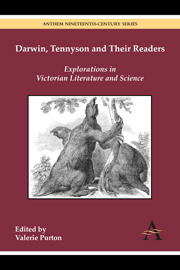Book contents
- Frontmatter
- Contents
- Introduction
- Chapter 1 Tennyson's ‘Locksley Hall’: Progress and Destitution
- Chapter 2 ‘Tennyson's Drift’: Evolution in The Princess
- Chapter 3 History, Materiality and Type in Tennyson's In Memoriam
- Chapter 4 Darwin, Tennyson and the Writing of ‘The Holy Grail’
- Chapter 5 ‘An Undue Simplification’: Tennyson's Evolutionary Afterlife
- Chapter 6 ‘Like a Megatherium Smoking a Cigar’: Darwin's Beagle Fossils in Nineteenth-Century Popular Culture
- Chapter 7 ‘No Such Thing as a Flower […] No Such Thing as a Man’: John Ruskin's Response to Darwin
- Chapter 8 Darwin and the Art of Paradox
- Chapter 9 Systems and Extravagance: Darwin, Meredith, Tennyson
- Chapter 10 T. H. Huxley, Science and Cultural Agency
- Notes on Contributors
Chapter 1 - Tennyson's ‘Locksley Hall’: Progress and Destitution
- Frontmatter
- Contents
- Introduction
- Chapter 1 Tennyson's ‘Locksley Hall’: Progress and Destitution
- Chapter 2 ‘Tennyson's Drift’: Evolution in The Princess
- Chapter 3 History, Materiality and Type in Tennyson's In Memoriam
- Chapter 4 Darwin, Tennyson and the Writing of ‘The Holy Grail’
- Chapter 5 ‘An Undue Simplification’: Tennyson's Evolutionary Afterlife
- Chapter 6 ‘Like a Megatherium Smoking a Cigar’: Darwin's Beagle Fossils in Nineteenth-Century Popular Culture
- Chapter 7 ‘No Such Thing as a Flower […] No Such Thing as a Man’: John Ruskin's Response to Darwin
- Chapter 8 Darwin and the Art of Paradox
- Chapter 9 Systems and Extravagance: Darwin, Meredith, Tennyson
- Chapter 10 T. H. Huxley, Science and Cultural Agency
- Notes on Contributors
Summary
The composition of Tennyson's ‘Locksley Hall’ during 1837—38 coincided with the foundation of the Corn Law League, the promulgation of the People's Charter and the controversy over the enforcement of the New Poor Law, whilst its publication in 1842 was marked by the riots over the rejection of the Chartist petition. These five years have been characterized as ‘the grimmest period in the history of the nineteenth century’, a moment when ‘Industry came to a standstill, unemployment reached hitherto unknown proportions, and with high food prices and inadequate relief the manufacturing population faced hunger and destitution.’ Tennyson's poem is precariously balanced between utopian and scientifically orientated visions of the future — as when the feverish protagonist recounts how he dipped ‘into the future far as human eye could see’ and ‘Saw the vision of the world and all the wonder that could be’ (15—16) — and an ominous sense of social change: ‘Slowly comes a hungry people, as a lion creeping nigher, / Glares at one that nods and winks behind a slowly-dying fire’ (135—6). The predominant mood is misanthropic, the hero urging his army companions to leave him alone to contemplate the ‘dreary gleams about the moorland flying over Locksley Hall’ (4) and complaining of the ‘social wants’ (59) and ‘social lies’ (60) of contemporary society.
- Type
- Chapter
- Information
- Darwin, Tennyson and their ReadersExplorations in Victorian Literature and Science, pp. 1 - 12Publisher: Anthem PressPrint publication year: 2013

